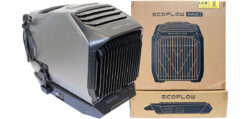
Practical testing …
EcoFlow Wave 2 test in practice
EcoFlow Wave 2 simply set up …
EcoFlow Wave 2 with one exhaust air duct …
EcoFlow Wave 2 with two exhaust air ducts …
EcoFlow Wave 2 control via Bluetooth and/or WLAN …
EcoFlow Wave 2 condensation outlet …
EcoFlow Wave 2 heating capacity …
EcoFlow Wave 2 cooling capacity …
EcoFlow Wave 2 volume …
EcoFlow Wave 2 firmware update …
EcoFlow Wave 2 powered by solar …
EcoFlow Wave 2 test in practice …
After all this information about air conditioning and installation, let’s move on to the practical testing of the EcoFlow Wave 2. You have the option of operating the mobile air conditioning either outdoors directly using a rechargeable battery or via a power connection and can then select different operating modes depending on the scenario. We have shown here on our Funkyhome YouTube Channel in an EcoFlow Wave2 thermal imaging video how impressively fast the air conditioning cools down or heats up.
Note: Please allow our cookies first to see this external content!
EcoFlow Wave 2 easy to set up …
The Wave 2 can be set up outdoors, for example at the campsite or on the terrace, simply for cooling or heating. We have explained all possible operating modes in detail here in the EcoFlow Wave 2 video.
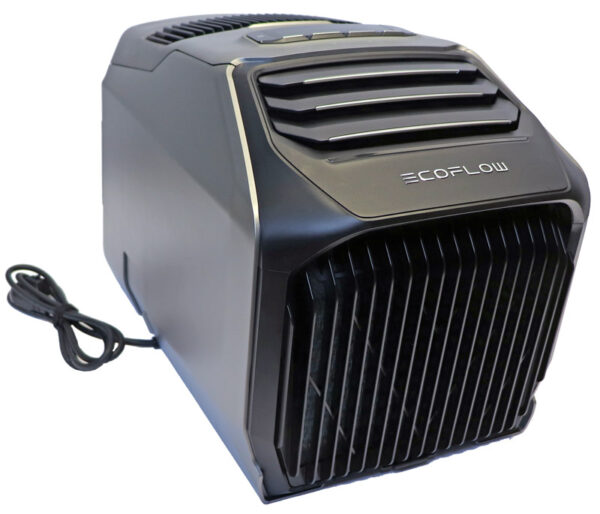
EcoFlow Wave 2 with one exhaust air duct …
However, it is also possible to connect an exhaust air duct, which can be fed into a tent, for example, and the Wave 2 can remain outside the tent. In this case, however, the device should be set up protected from rain, as the Wave 2 system is not waterproof, but only IPX4, i.e. protected against splashing water. The advantage of this operating mode is that the volume in the tent or room is reduced.
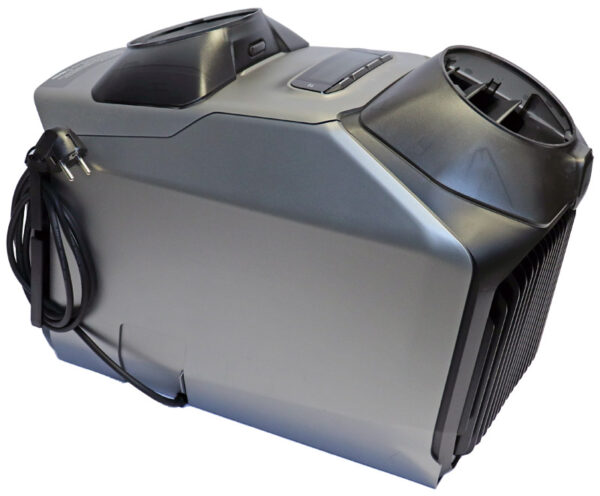
If you want to operate the EcoFlow Wave 2 with an exhaust air duct, this is attached to the upper connection at the front as shown here and locked in place with a quarter turn. Incidentally, the hose can be pulled out up to approx. 1.40 meters.
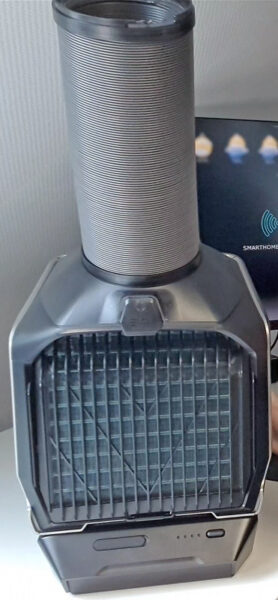
EcoFlow Wave 2 with two exhaust air ducts …
However, the Wave 2 can also be connected to two exhaust air hoses that allow complete circulation outside a room, resulting in a more efficient recirculating air cooling unit. Although this is more effective, it does make the whole thing a little more unwieldy. In addition, the two hoses really should be completely separated from the interior, and this can be achieved with the supplied window ventilation plate, which can also be used in a motorhome or caravan.
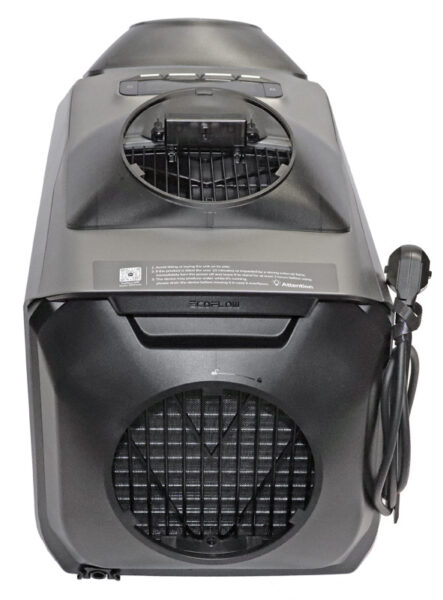
If EcoFlow now manages to offer a mobile split-air conditioning system of this size, at least the large hoses would be saved and the evaporator could be separated from the condenser via refrigeration pipes. We are really hoping for a possible EcoFlow Wave 3 🙂
EcoFlow Wave 2 control via Bluetooth and/or WLAN …
Incidentally, the Wave 2 can be controlled very conveniently via Bluetooth and/or WLAN with a smartphone or tablet using the EcoFlow app, which we have explained in detail on Funkyhome.de and here in the EcoFlow Wave 2 video we also go into more detail about the EcoFlow Wave 2 app.
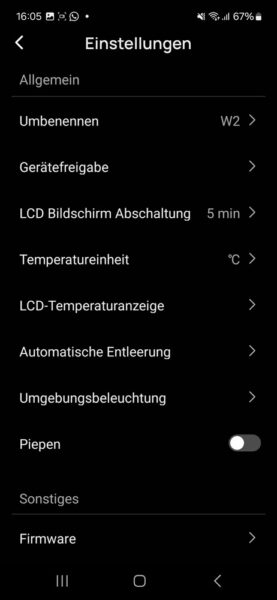
The Wave 2 can be controlled via an EcoFlowSmart Plug. Alternatively, the Wave 2 can even be integrated into an EcoFlow automation system within the app and, for example, only switch on when the solar input power is high via the EcoFlow PowerStream microinverter and switch off when the EcoFlow Delta 2 Max battery level is low. This allows you to use your energy supply for automatic cooling if required.
You can conveniently choose between cooling mode, heating mode and fan mode.
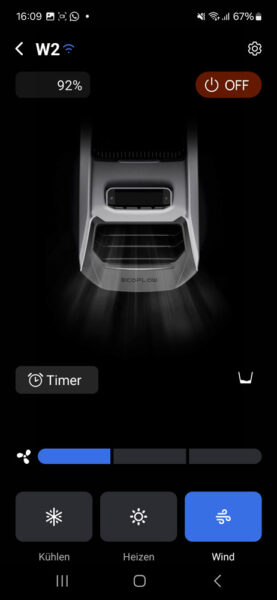
Here you can select different strengths and also immediately see the battery status and the possible battery life.
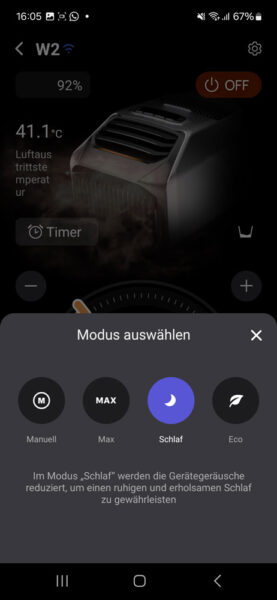
EcoFlow Wave 2 condensation water outlet …
Another detail is also important and that is the water outlet. Depending on the level of humidity, the resulting condensation moisture can be released into the ambient air via flash distillation. From 70 % humidity or in heating mode, however, water accumulates in the tank, which should be emptied either at regular intervals or preferably continuously.
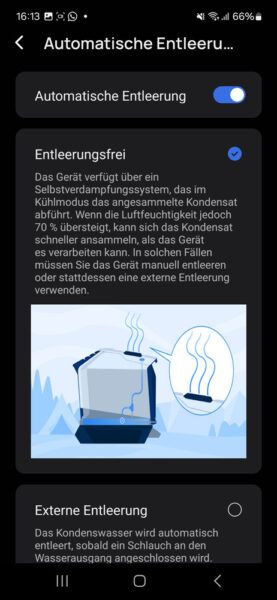
As you can see, there are always downsides to such appliances, because even EcoFlow cannot override physics.
EcoFlow Wave 2 heating output …
EcoFlow promises that the Wave 2 can raise the air temperature from 20 °C to 30 °C in just 5 minutes with a volume of 10 m³ using 6100 BTU/h heating power. Of course, we tested this and tried out the air conditioning in a small 1.70 x 2.00 x 2.40 meter room. The room volume therefore corresponds to just over 8 m³. Despite the approx. 18% smaller room volume, this took around 6 minutes in our test. We measured the temperature here near the floor. This should actually have been quicker in the small room, but the relatively cool walls probably contributed to the heated air being cooled down again slightly straight away. The power consumption in heating mode is 540 to 820 watts.
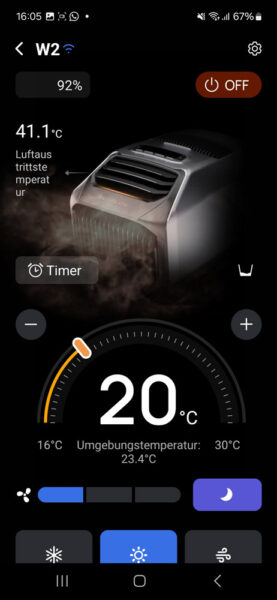
EcoFlow Wave 2 cooling capacity …
EcoFlow promises that the Wave 2 can reduce the air temperature from 30°C to 20°C in just 5 minutes with a cooling capacity of 5100 BTU/h and a volume of 10 m³. Of course, we also tested this and set up the air conditioning again in the small 1.70 x 2.00 x 2.40 meter room. The EcoFlow Wave 2 also needed a little less than 4 minutes to warm up the room with a volume of approx. 8.16 m³ and a temperature of just under 30° C. We measured the temperature just below the ceiling. Here, the EcoFlow benefited from the fact that the walls cooled a little during our measurement. In summer, of course, it’s a different story with heated walls and heated furniture in the home, caravan or camper. The power consumption for cooling is 495 to 820 watts.
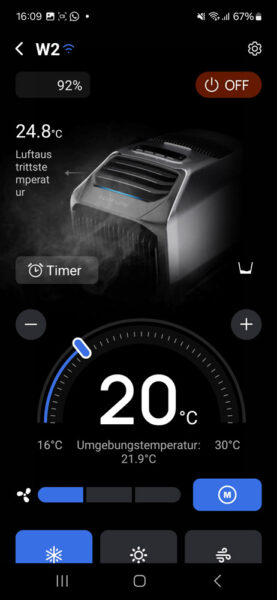
EcoFlow Wave 2 volume …
For some it is quiet, for others it is loud. The volume depends on how much the device is being used and how high the fan speed is set. Although EcoFlow advertises a quiet 44 dB in sleep mode, 44 dB is also audible and, depending on the cooling or heat output, the Wave 2 volume can reach up to 56 dB, at which point even a conversation becomes difficult. On average, we find the EcoFlow Wave 2 air conditioning to be relatively loud, but this is our personal impression, which you can see for yourself in the EcoFlow Wave 2 video.
EcoFlow Wave 2 Firmware …
EcoFlow regularly releases updated firmware versions, which should be installed as soon as possible in most cases. Major errors such as the EcoFlow security vulnerabilities, which we have also explained in the following video, have fortunately already been fixed with firmware updates.
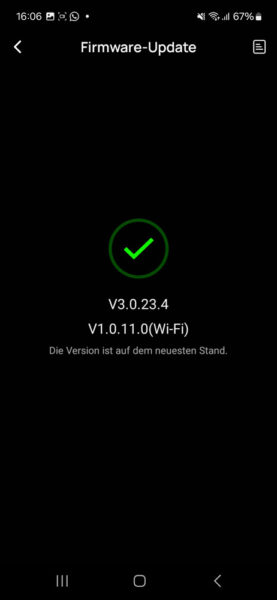
EcoFlow Wave 2 powered by solar …
The EcoFlow Wave 2 battery can even be charged directly via a solar panel, as there is an XT60 input for connecting a solar panel or car, which can then be used to charge the battery directly via direct current. As only 200 watts can be fed in by car or 400 watts by solar (max. 11-60V or max. 13A), this is not sufficient for cooling or heating operation, but is only used for charging or for operation in fan mode. For continuous self-sufficient operation, you therefore need a power station with its own PV input and high output power, such as the EcoFlow Delta 2 Max, where you can then connect the Wave2 to the AC output.
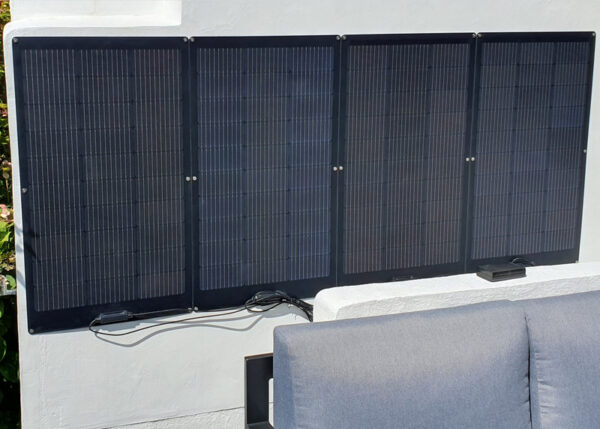
As you can see from the examples above, the Wave 2 is very versatile in practice and apart from the relatively high volume, there is hardly anything to criticize about the implementation, although we would still like to see reduced air conditioning operation via solar and reduced heating operation via solar.
Now we come to our Wave 2 test result …
EcoFlow Wave 2 Result and general impression …
